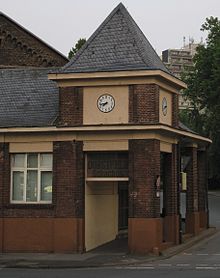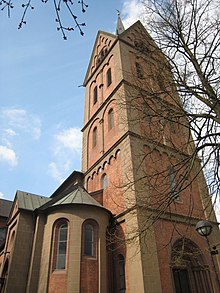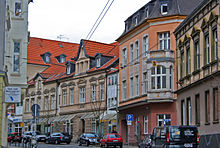Dorstfeld
|
Dorstfeld
City of Dortmund
Coordinates: 51 ° 30 ′ 46 ″ N , 7 ° 25 ′ 27 ″ E
|
|
|---|---|
| Height : | approx. 80 m above sea level NHN |
| Area : | 6.12 km² |
| Residents : | 14,943 (Dec. 31, 2019) |
| Population density : | 2,440 inhabitants / km² |
| Incorporation : | June 10, 1914 |
| Postcodes : | 44147, 44149, 44379 |
| Area code : | 0231 |
| Statistical District : | 03 |
|
Location of Dorstfeld in Dortmund
|
|
Dorstfeld is a district in the city center city-west and is located in the west of Dortmund . In the north Dorstfeld borders on Wischlingen and Huckarde , in the west on Marten , in the southwest on Oespel , in the south on Barop and the Technical University of Dortmund and in the east on the city center.
History and present
Dorstfeld was mentioned around 880 in a Werden land register as dorstidfelde . A later variant of the place name is Durstveld . The Hellweg was mentioned in documents as Dorstfelder Helewege as early as 1345. Dorstfeld was at the crossing of the trade route over the Emscher .
This location, which was advantageous for most of the times, also had another, strategic and destructive side during the Great Dortmund Feud . The Emscher was at Dorstfeld the border between Dortmund and the county of Mark . As early as 1388, with the beginning of the feud , Count Engelbert III. von der Mark build a fortification in Dorstfeld, described as a castle. To do this, he not only had the Emscher bridge destroyed, but also a mill and the stone pavement so that the material could be used for construction. However, the fortification was razed in January 1390 after the end of the feud by the troops of the Dortmund citizens.
Dortmund troops had already made advances into the surrounding area during the siege of their city. They looted and pillaged the villages in the area. Dorstfeld was attacked twice like this, in spring and autumn 1389.
The year 1840 was significant for the development of Dorstfeld. At that time, Mayor Wegmann moved the administrative headquarters of the Lütgendortmund office to Dorstfeld. In 1886 the Dorstfeld office with the communities Dorstfeld, Huckarde, Marten, Rahm and Wischlingen became independent. The population had grown rapidly in the course of industrialization. But just a few decades later, on June 10, 1914, Dorstfeld was incorporated into the city of Dortmund.
An important event in the development of German trade unions is associated with Dorstfeld. On August 18, 1889, 200 delegates from 66 mines in Dorstfeld founded the association for the protection and promotion of mining interests in Rhineland and Westphalia . Friedrich Bunte was elected first chairman . During the previous miners 'strike he had been the workers' deputy to Kaiser Wilhelm II .
The streetscape in Dorstfeld is reminiscent of the district's mining past. Until its closure in 1963, the Dorstfeld colliery was the largest local employer. Today, mining dumps , colliery colonies and the administrative and chewing buildings that are now part of the Dortmund Adult Education Center are a reminder of mining history. Dorstfeld was the location of the mechanical engineering company Orenstein & Koppel . The tram depot of the Dortmunder Stadtwerke DSW21 has been located north of the Dorstfelder Hellweg since 1967 , and was enlarged and renewed in 1996 (Stadtbahn main workshop).
In the 1970s, Dorstfeld was the scene of squatting. At that time, houses around Wörthstrasse were occupied by mostly student residents in order to counteract clear-cut restoration. In the 1980s there was a major contaminated site scandal surrounding a new housing estate in Dorstfeld-Süd.
After heavy rainfall of up to 200 l / m² locally, the Emscher and Roßbach floods occurred in the Dortmund area on July 26, 2008, particularly affecting the districts of Dorstfeld and Marten. The Emscher reached new high water levels at many measuring points. For example, a water level of over 520 centimeters was measured at the gauge in Mengede, with a usual level of around 100 centimeters.
The district received national attention at the end of 2009 after it became known that an anti-fascist family had been subjected to attacks for months. Several times, newspapers and TV magazines pointed to the strong neo-Nazi scene in the district, which made itself felt through attacks on dissidents and foreigners. Sven Kahlin, a leader of the now banned National Resistance Dortmund group who has been convicted of manslaughter of a punk and is primarily active in this district, demanded in March 2010: Dortmund is and will remain our city! according to the concept of the National Liberated Zones .
Population development
| year | 1987 | 2003 | 2008 | 2013 | 2016 | 2019 |
|---|---|---|---|---|---|---|
| Residents | 16,249 | 16,022 | 15,568 | 15,295 | 15,457 | 14,943 |
statistics
Structural data of the population of Dorstfeld:
- Share of the population under 18-year-olds: 16.0% [Dortmund average: 16.2% (2018)]
- Share of the population of at least 65-year-olds: 19.8% [Dortmund average: 20.2% (2018)]
- Proportion of foreigners: 18.8% [Dortmund average: 18.8% (2019)]
- Unemployment rate: 12.0% [Dortmund average: 11.0% (2017)]
The average income is around 15% below the Dortmund average.
Spatial structure
Historically, Dorstfeld can be divided into different areas. Until the 20th century the Emscher represented the border with Dortmund. Dorstfeld had a town center on Hellweg, directly west of the Emscher. The two churches of the Protestant and Catholic parishes of Dorstfeld are located here. Even today there is still a weekly market on Wilhelmsplatz. The light rail traverses the historical center in an east-west direction (U43 and U44). Just south of the town is the S-Bahn -Knotenpunkt Dortmund Dorstfeld where the S-Bahn lines 1, 2 and 4 hold.
In order to create living space for the workers of the Dorstfeld colliery, the settlement Oberdorstfeld (popularly also Oberdorf) was built between 1913 and 1919 near the colliery, on today's Wittener Strasse and thus far southwest of the village of Dorstfeld , which gives the entire area its name to this day . Oberdorstfeld has its own community.
In order to linguistically differentiate the historic town center from Oberdorstfeld, the former is now often referred to as Unterdorstfeld (also Unterdorf or Dorstfeld Mitte ).
After the incorporation into the city of Dortmund, the area of Dorstfeld expanded further east over the Emscher . In the southeast, the Tremonia colliery , an industrial area and the Dortmunder Feld freight station was built , near which the Tremonia settlement , which is still popularly called "Negerdorf" , was built on the Emscher . The term comes from the Westphalian name "dat nigge Dorp" ("the new village") and not because the miners of the neighboring colliery had to walk home unwashed.
To the east of the Emscher, on today's Rheinische Strasse, the main access road to the city center, additional, dense buildings and industry emerged. The border to the city center is the Dorstfelder Brücke, and the entire area between Dorstfeld and the bridge is often called the Dorstfelder Brücke .
In the second half of the 20th century, another settlement was built between Dortmunder Feld and Oberdorstfeld. Large parts of the settlement consist of flat residential buildings, the Hannibal is outstanding in terms of architecture and height . The settlement was connected with the underground train station Dortmund-Dorstfeld Süd to the then newly built line S1 (partly on the tracks of the disused Dorstfeld colliery ) and is therefore often called Dorstfeld Süd , but is often also part of Oberdorstfeld.
Attractions
The Schulte-Witten building , which today serves as a public library , and the DASA - Working World Exhibition as part of the Federal Institute for Occupational Safety and Health (BAuA) are considered worth seeing . Dorstfeld has its own indoor swimming pool (Westbad) and many sports clubs. The listed Protestant church and the former Schulte-Witten mansion are also noteworthy .
Personalities
- Ludwig Bendix (born June 28, 1877 in Dorstfeld; † January 3, 1954 in Oakland ), German lawyer and economist
- Werner Sengenhoff (born April 7, 1906 in Dorstfeld, † December 6, 1944 in Niedermarsberg), psychiatrist who was involved in euthanasia crimes during the time of National Socialism
- Hans-Eberhard Urbaniak (born April 9, 1929), politician (SPD)
- Heinz-Werner Meyer (born August 24, 1932 in Harburg ; † May 9, 1994 in Siegburg ) was a member of the SPD in the North Rhine-Westphalian state parliament from 1975 to 1984 as Dorstfelder . From 1987 to 1990 he was a member of the German Bundestag, but in the constituency of Recklinghausen I. In 1985 he was elected chairman of IG Bergbau und Energie and then in 1990 chairman of the German Trade Union Federation (DGB) . His sudden death in 1994 was a great loss for the union movement. The youth leisure center Heinz-Werner-Meyer-Treff at Hannibal is named after him.
- Lothar Emmerich (born November 29, 1941 in Dorstfeld, † August 13, 2003 in Hemer ), football player
- Alfred Nobel , between 1860 and 1864 he lived in Dorstfeld, among others, and experimented with explosives in mining at the Dorstfeld colliery there.
- Ralf Loose (born January 5, 1963 in Dorstfeld) is a former German soccer player and today's soccer coach.
Web links
- Dorstfeld in the Westphalia Culture Atlas
Individual evidence
- ↑ Population figures in the statistical districts on December 31, 2019 (PDF)
- ↑ Rudolf Kötzschke (Ed.): Die Urbare der Abtei Werden ad Ruhr (= Publications of the Society for Rhenish History XX: Rheinische Urbare ). Vol. 2: A. The land register from 9. – 13. Century, ed. by Rudolf Kötzschke, Bonn 1908, reprint Düsseldorf 1978; Vol. 3: B. Stock books, lifting and interest registers from the 14th to the 17th century, Bonn 1908, reprint Düsseldorf 1978; Vol. 4, I: Introduction and Register, I. Name Register , ed. by Fritz Körholz, Düsseldorf 1978; Bd. 4, II: Introduction, Chapter IV: The economic constitution and administration of the large manor in Werden, subject register, ed. by Rudolf Kötzschke, Bonn 1958.
- ↑ Stephanie Reekers: The regional development of the districts and communities of Westphalia 1817-1967 . Aschendorff, Münster Westfalen 1977, ISBN 3-402-05875-8 , p. 227 .
- ^ Rainer Guski : Effects of pollutants, noise and radioactivity. (PDF; 315.58 kB) In: Lecture Introduction to Environmental Psychology WS 2000/2001. Archived from the original on December 21, 2014 ; Retrieved November 11, 2014 .
- ↑ Kahlin's statement on a server belonging to this group on March 29, 2010, accessed on October 3, 2012. Although the group and its “information portal” had been banned by the Ministry of the Interior in North Rhine-Westphalia in August 2012 , the website remained online. In addition, Kahlin's contribution, drawn by name, contains the usual insults of the state as a “terminally ill system” and “dying rat”. Kahlin was released early on probation in autumn 2010 because of a favorable social prognosis (“no new acts are to be expected”, so there is no risk of repetition of the WAZ ). In November 2011 he again attacked two young people and seriously injured them WAZ . Kahlin was sentenced to imprisonment for this, a favorable social prognosis was denied this time. Mirror online
- ↑ Population share of the under 18 year olds Statistical Atlas 2019 (PDF file)
- ↑ Population share of at least 65-year-olds Statistical Atlas 2019 (PDF file)
- ↑ Nationalities in the statistical districts on December 31, 2019 (PDF file)
- ↑ Unemployment rates by statistical district on June 30, 2017 (PDF file)
- ↑ Oliver Volmerich, Susanne Riese: Forgotten place - the Emscher meadows . ( waz.de [accessed on September 10, 2017]).
- ↑ Former members of the state parliament of North Rhine-Westphalia , accessed on April 25, 2013.







